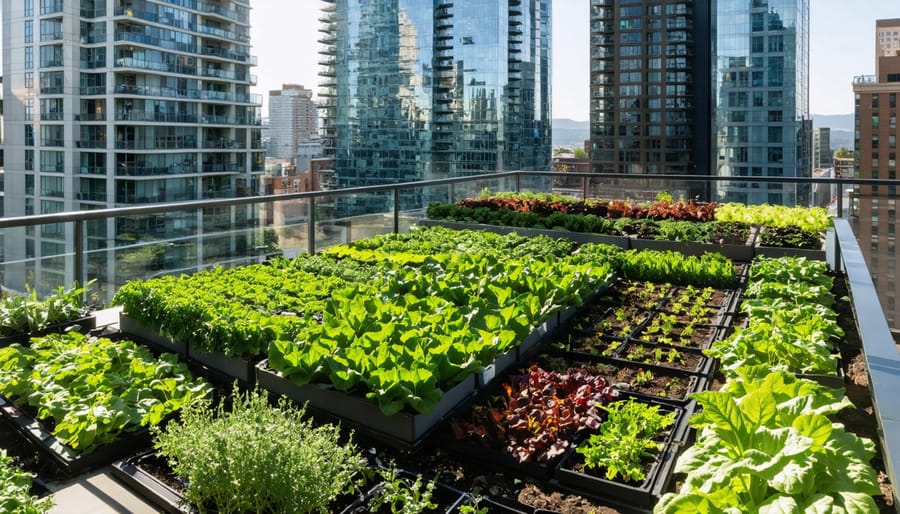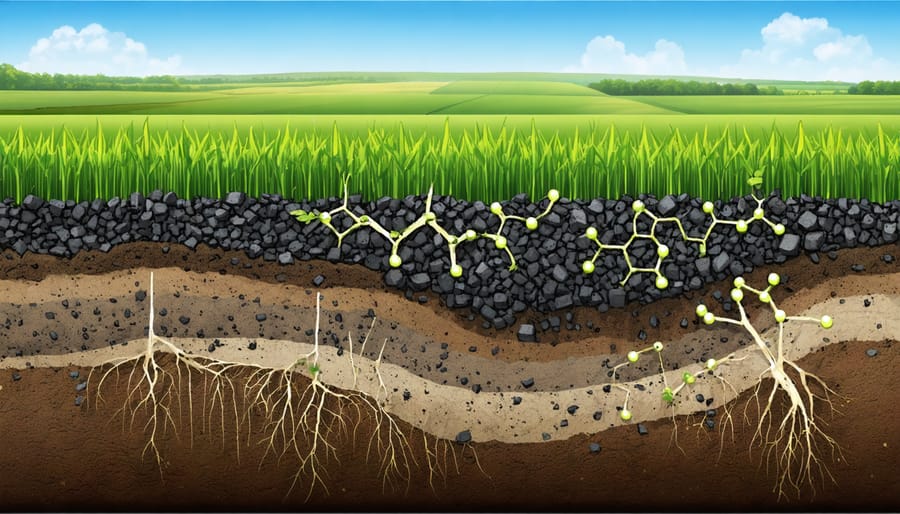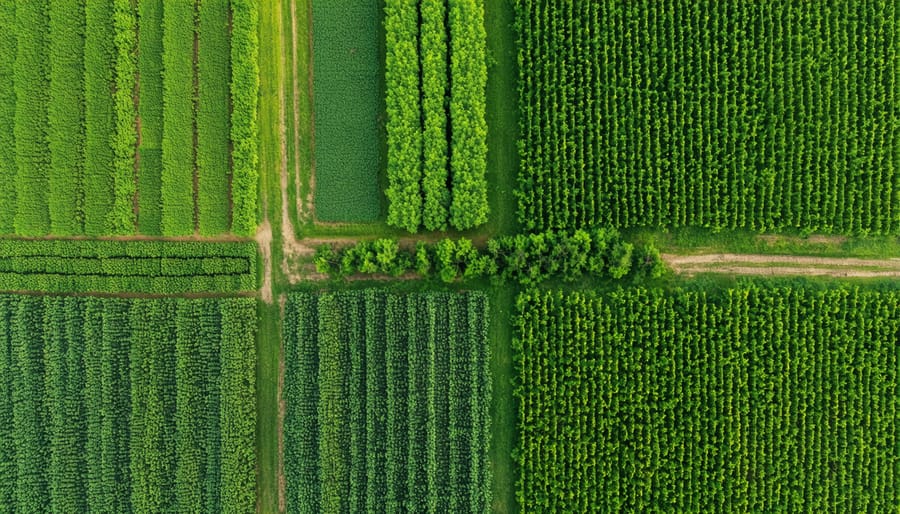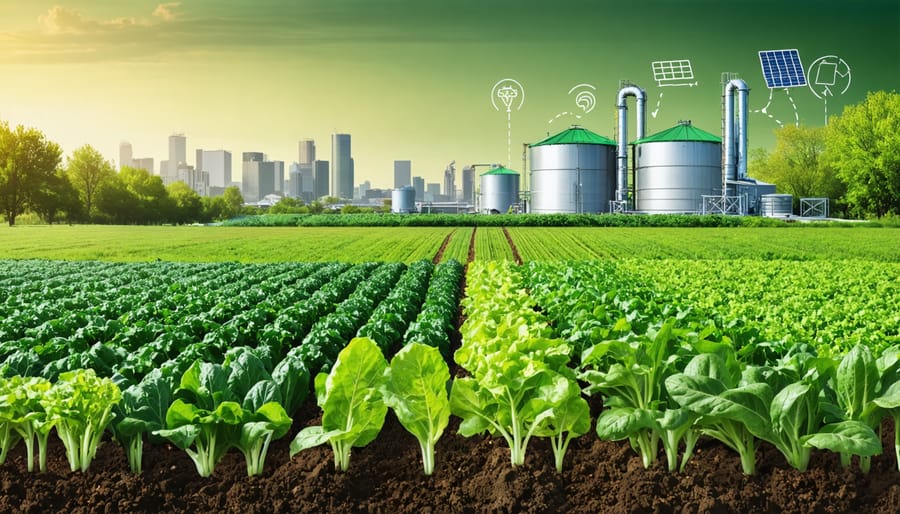Across Alberta’s sprawling farmlands, wind energy is transforming the agricultural landscape, offering farmers a powerful opportunity to harvest not just crops, but also sustainable power from their land. Wind turbines, standing tall against Prairie skies, now represent more than just energy independence—they’re becoming vital contributors to farm sustainability and economic resilience.
For Canadian farmers, wind energy presents a unique dual-income opportunity: maintaining traditional agricultural operations while generating clean, renewable power. With Alberta’s wind resources among the strongest in North America, averaging speeds of 6-7 meters per second in prime locations, the potential for agricultural wind power integration has never been more promising.
The marriage of wind energy and farming practices has already proven successful across hundreds of Alberta farms, where turbines occupy less than 1% of the land while allowing normal farming operations to continue uninterrupted. Modern turbine technology can generate enough electricity to power 50-100 local homes from a single installation, creating a sustainable energy source that works in harmony with traditional farming practices.
As we face increasing pressure to reduce carbon footprints while maintaining agricultural productivity, wind energy offers a practical solution that aligns perfectly with the values and needs of Canadian farming communities.
Why Wind Power Makes Sense for Alberta Farms
Alberta’s Wind Energy Potential
Alberta’s unique geography and climate create ideal conditions for wind energy generation, particularly in the southern region where wind speeds consistently average 6-8 metres per second at turbine height. The Chinook wind patterns, especially prevalent along the eastern slopes of the Rocky Mountains, provide reliable year-round energy potential.
The province’s wind energy capacity has grown significantly, with successful installations demonstrating the viability of farm-based wind projects. Southern Alberta farmers have reported particularly strong results, with some generating enough power to meet their entire farm’s electrical needs and sell surplus back to the grid.
Key wind corridor regions include Pincher Creek, Fort Macleod, and the Crowsnest Pass area, where average wind speeds make turbine installation especially productive. Recent assessments indicate that Alberta could potentially generate up to 150,000 megawatts of wind power, though only a fraction of this capacity is currently being utilized.
For farmers considering wind energy, local wind mapping tools are available through Alberta Agriculture to help assess specific site potential. The most promising locations typically combine elevated terrain with open agricultural land, characteristics common to many Alberta farming operations.

Economic Benefits for Your Farm
Investing in wind energy can create significant financial advantages for your farm operation. Beyond reducing or eliminating your electricity bills, renewable energy investments can generate additional income streams through various channels. Many Alberta farmers report earning between $15,000 to $25,000 annually per turbine through power purchase agreements with local utilities.
The Alberta Renewable Energy Program offers grants covering up to 35% of installation costs, significantly reducing your initial investment. Additionally, farmers can benefit from accelerated depreciation rates on wind energy equipment, leading to substantial tax advantages in the first few years of operation.
By participating in Alberta’s micro-generation program, you can sell excess power back to the grid at competitive rates. Several local farms have reported complete system payback within 8-10 years, with ongoing revenue generation thereafter. Some agricultural operations have also found success in partnering with neighbouring farms to create small wind cooperatives, sharing both costs and benefits while strengthening community ties.
Consider that wind energy systems typically have a 20-25 year lifespan, providing long-term financial stability and protection against rising energy costs.
Getting Started with Farm Wind Energy
Assessing Your Farm’s Wind Resource
Before investing in wind energy infrastructure, it’s crucial to thoroughly evaluate your farm’s wind resource potential. As one of the most effective climate solutions for Alberta farms, wind power requires careful assessment to ensure optimal results.
Start by collecting wind speed data at your location using an anemometer installed at the height where you plan to place your turbine. Most agricultural wind installations require at least 12 months of consistent measurements to account for seasonal variations. Environment Canada’s wind resource maps can provide initial guidance, but local measurements are essential for accurate planning.
Consider working with a certified wind resource assessor who can help you interpret data and identify the best turbine locations on your property. They’ll evaluate factors such as:
– Average wind speeds throughout the year
– Wind direction patterns
– Topographical features that might affect airflow
– Obstacles like buildings or tree lines
– Seasonal weather patterns
Many Alberta agricultural extension offices offer wind assessment tools for loan, and some rural municipalities provide funding for professional assessments. Local wind energy cooperatives can also share valuable data from nearby installations.
Remember that even small variations in location can significantly impact wind energy potential, so take time to thoroughly assess multiple sites on your property before making investment decisions.
Choosing the Right Wind System
When selecting a wind system for your farm, it’s essential to consider both your energy needs and local wind conditions. Alberta farmers typically choose between two main turbine types: horizontal-axis wind turbines (HAWTs) and vertical-axis wind turbines (VAWTs). HAWTs are the more common choice, offering higher efficiency in open agricultural settings where wind flows are consistent.
For most Alberta farm operations, medium-sized turbines ranging from 10 to 50 kilowatts provide the best balance of power generation and cost-effectiveness. These systems can power multiple farm buildings, irrigation systems, and processing equipment while potentially feeding excess energy back into the grid.
Your farm’s topography plays a crucial role in turbine placement. The ideal location should have average wind speeds of at least 14.4 kilometres per hour and minimal obstruction from buildings or tree lines. Consider installing anemometers for at least six months to accurately measure your site’s wind resources before making a final decision.
Grid-connected systems are popular among Alberta farmers, allowing for reliable power access while benefiting from net metering programs. However, off-grid configurations with battery storage can be valuable for remote operations or as backup power sources during outages.
Working with certified installers familiar with agricultural applications is crucial. They can help determine the optimal turbine height, which typically ranges from 24 to 37 metres for farm installations, and ensure your system meets local building codes and safety standards.

Installation and Maintenance Considerations
When installing a wind energy system on your farm, location selection is crucial. The ideal spot should have consistent wind speeds of at least 20 km/h and be free from obstacles like tall buildings or tree lines. Most Alberta farms benefit from positioning turbines on elevated ground, typically 30-40 metres above surrounding structures.
Regular maintenance is essential for optimal performance. Schedule bi-annual inspections during spring and fall – times when wind patterns are typically moderate. During these checks, focus on blade condition, looking for signs of wear or damage from ice and debris. Keep detailed maintenance records to track performance patterns and anticipate potential issues.
Local Alberta farmers report that winter maintenance requires special attention. Install heating elements in the turbine mechanisms to prevent ice buildup, and ensure all components are rated for our extreme temperature ranges (-40°C to +30°C). Many successful operators partner with local technicians for regular servicing, building valuable relationships within the agricultural community.
Foundation stability is particularly important in our prairie soil conditions. Work with certified installers who understand local soil composition and frost patterns. Consider installing wind measurement equipment for at least one year before turbine placement to ensure optimal positioning and expected power generation capacity.
Remember to schedule routine lubrication of moving parts and tightening of bolts – tasks that many farmers handle themselves between professional service visits. This proactive approach significantly extends system lifespan and maintains consistent energy production.
Real Success Stories: Alberta Farmers Leading the Way
The Morrison Family Farm
Located just outside of Lethbridge, Alberta, the Morrison Family Farm has been a testament to innovative sustainable agricultural practices since their bold transition to wind power in 2019. The third-generation dairy farm, operated by Sarah and James Morrison, made the decision to install two 100kW wind turbines after facing rising energy costs that threatened their operation’s viability.
“Our monthly electricity bills were becoming unsustainable,” shares Sarah Morrison. “We were spending upwards of $4,000 per month to power our milking equipment and cooling systems. Something had to change.”
Working with local renewable energy specialists and accessing funding through Alberta’s On-Farm Energy Management Program, the Morrisons invested $450,000 in their wind power system. The results have exceeded their expectations. Within the first year, their energy costs dropped by 75%, and the farm now generates surplus power during windy periods, which they sell back to the grid.
The turbines power their entire dairy operation, including the automated milking system for their 200-head herd, milk cooling equipment, and barn ventilation. During peak wind conditions, excess energy supports their irrigation systems and greenhouse operations.
“It’s not just about saving money,” James explains. “We’re setting an example for our children and showing our community that farming can evolve while respecting our agricultural heritage.”

Sustainable Acres Cooperative
Located just outside of Lethbridge, Alberta, the Sustainable Acres Cooperative stands as a shining example of community-driven wind energy success. In 2019, fifteen local farming families joined forces to establish a shared 10-megawatt wind installation spanning their adjacent properties. The project now powers over 3,000 homes and provides supplemental income for participating farmers through power generation credits.
The cooperative’s journey began when Sarah McKenzie, a third-generation wheat farmer, noticed how consistent wind patterns across their properties could be harnessed for sustainable energy production. After consulting with neighbouring farms and renewable energy experts, the group secured funding through a combination of government grants and collective investment.
Today, the six turbines operating on Sustainable Acres generate an average of 35,000 megawatt-hours annually, while allowing traditional farming operations to continue underneath and between the installations. The project has created five permanent maintenance positions and helped stabilize income for participating farms during challenging crop years.
“The beauty of this setup is how it brings our community together,” explains McKenzie. “We’re not just sharing resources; we’re building a sustainable future for our children while maintaining our agricultural heritage.” The cooperative’s success has inspired three similar projects across southern Alberta, demonstrating how wind energy can complement existing farming operations while strengthening rural communities.
Navigating Regulations and Support Programs
Provincial Requirements
In Alberta, installing wind energy systems requires compliance with specific provincial regulations and permit requirements. Farmers must first obtain a development permit from their local municipality, which typically involves a site assessment and consultation with neighboring properties. The Alberta Utilities Commission (AUC) requires approval for any wind project exceeding 1 megawatt, while smaller systems may qualify for simplified micro-generation approvals through your local utility provider.
Environmental impact assessments are mandatory for larger installations, particularly concerning wildlife protection and noise levels. The AUC’s Rule 007 outlines specific requirements for noise impact assessments, which must demonstrate compliance with Directive 038’s permissible sound levels of 40 dBA nighttime and 50 dBA daytime at neighboring residences.
Agricultural landowners should also review their municipal land-use bylaws, as setback requirements and height restrictions vary by region. The Alberta Farm Implement Act may apply when connecting wind systems to existing farm infrastructure. Working with a certified installer familiar with Alberta’s regulations can streamline the approval process and ensure compliance with all necessary requirements.
Remember to notify your insurance provider and update your farm’s safety protocols to accommodate the new installation.
Financial Incentives and Resources
Farmers considering wind energy investments can access numerous financial support programs in Alberta. The Alberta Municipal Solar Program offers matching grants of up to $100,000 for renewable energy projects, including wind installations. Through Canada’s Agricultural Clean Technology Program, producers can receive up to 50% funding for qualifying wind energy systems.
Tax incentives are particularly attractive, with the Clean Energy Equipment tax write-off allowing farmers to deduct up to 100% of wind energy system costs in the first year. The Alberta Farm Fuel Benefit program extends additional savings for those integrating renewable energy into their operations, supporting Alberta’s sustainable farming future.
Local agricultural cooperatives often provide member financing options with competitive interest rates for wind energy projects. The Canadian Agricultural Partnership (CAP) offers specialized grants for environmental stewardship initiatives, including wind power implementation. Additionally, some rural municipalities provide property tax exemptions for land used for wind energy generation, making the investment even more attractive for farming operations.
As we’ve explored throughout this guide, wind energy presents a compelling opportunity for Alberta’s farming community to enhance sustainability while maintaining profitable operations. The combination of our region’s abundant wind resources and the increasing affordability of wind power technology makes this an ideal time to consider implementing wind energy solutions on your farm.
Remember that successful wind power integration starts with a thorough site assessment and careful planning. By working with local experts, understanding available incentives, and connecting with fellow farmers who have already embraced wind energy, you can develop a strategy that works for your specific needs and circumstances.
The benefits extend far beyond reducing energy costs. Wind power helps create a more resilient farm operation, contributes to environmental stewardship, and positions your farm for future sustainability requirements. Many Alberta farmers are already leading the way, demonstrating that wind energy and agriculture can work hand in hand to create stronger, more sustainable farming operations.
Take the first step by reaching out to local renewable energy consultants or connecting with agricultural extension services. Consider joining farming cooperatives focused on sustainable energy, where you can share experiences and resources with other forward-thinking farmers. The transition to wind energy isn’t just an investment in your farm – it’s an investment in the future of Canadian agriculture and our rural communities.
Together, we can harness Alberta’s wind resources to build a more sustainable and prosperous agricultural sector for generations to come.










